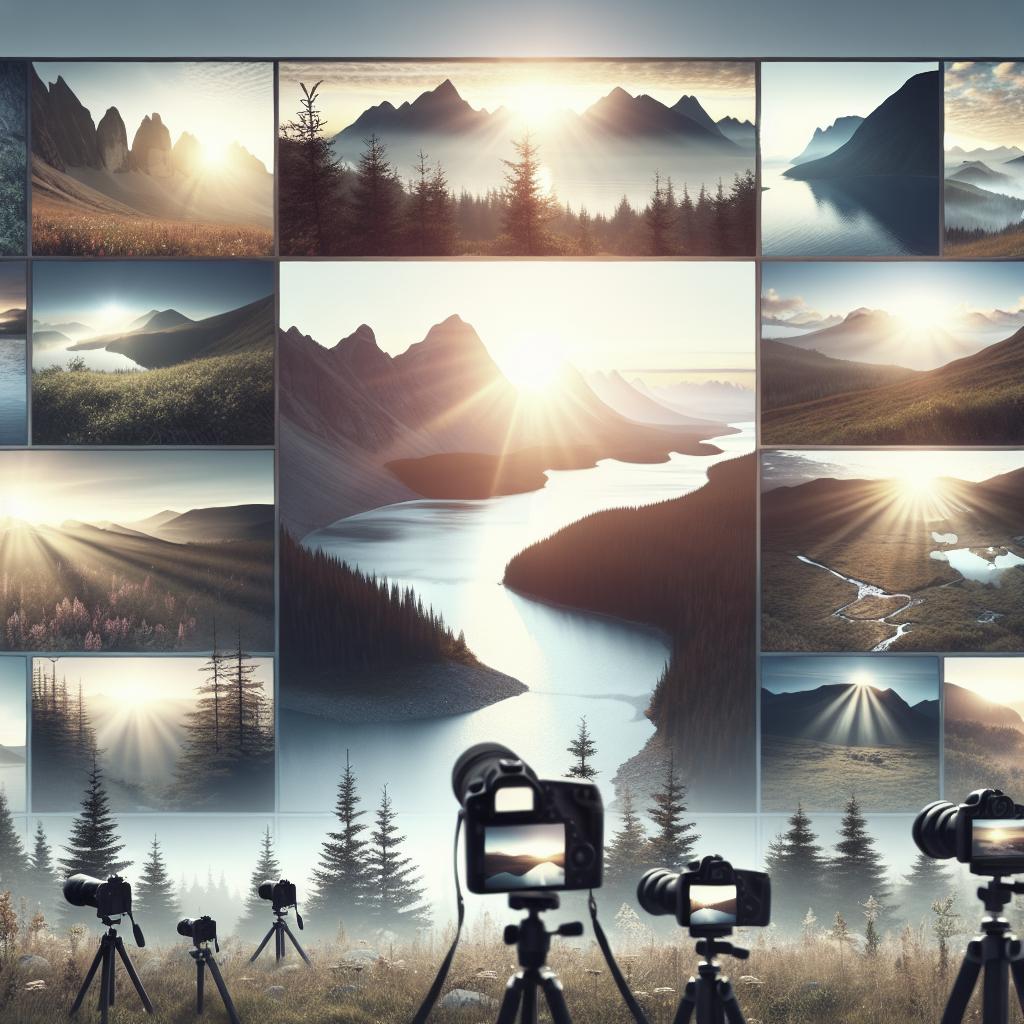Landscape photography is a magnificent artform that allows you to capture the beauty of the natural world. Whether you’re a novice looking to improve your skills or a seasoned photographer seeking new techniques, this comprehensive guide is designed to help you master the art of landscape photography. From choosing the right equipment to understanding lighting, composition, and post-processing, we’ll delve into the essential tips and techniques that will bring your landscape photos to life. Additionally, we’ll tackle some frequently asked questions to address common concerns and help you embark on your landscape photography journey with confidence.
What is Landscape Photography?
Landscape photography focuses on capturing natural sceneries and wide vistas. Unlike other forms of photography where the subject is usually front and center, landscape photography aims to showcase the beauty of the environment—mountains, forests, rivers, and skies. This type of photography often requires thoughtful composition and timing to highlight the grandeur of nature.
While landscape photography can seem straightforward, achieving breathtaking results involves understanding the specific techniques and equipment that best suit your environment. This genre is less about spontaneous moments and more about meticulously planned shots that convey a sense of place and natural splendor.
Top Landscape Photography Tips
1. Use a Good Camera
The cornerstone of any great photograph starts with a good camera. While it is true that skill outweighs the tool, having a camera that offers high resolution, dynamic range, and robust features can significantly enhance your shots. Look for cameras that support full-frame sensors, as they offer better light sensitivity and image quality.
For beginners, mirrorless cameras are an excellent choice due to their compact size and advanced features. Brands like Canon, Nikon, and Sony offer excellent options that cater to various budgets and experience levels. Ensure your camera supports manual adjustments, which are vital for landscape photography.
2. Equip Yourself with a Good Lens
An excellent camera is only half the battle; choosing the right lens is equally crucial. Wide-angle lenses are generally recommended for landscape photography because they can capture broader expanse of the scene, making your photos seem more immersive. A lens with a focal length between 14mm and 24mm is typically ideal.
Additionally, consider investing in prime lenses. Though they lack the zoom capabilities of telephoto lenses, primes often offer superior sharpness and less distortion. A good lens can be a game-changer, dramatically enhancing the quality of your landscape photos.
3. Invest in a Good Tripod
Sharpness is essential in landscape photography, and handholding your camera might not always produce the crisp results you desire, especially in low light conditions. A high-quality tripod ensures stability, reducing camera shake and allowing for longer exposures.
When choosing a tripod, consider factors like weight, height, and maximum load capacity. Lightweight carbon fiber tripods are portable and durable, making them an excellent option for outdoor shoots. Features like a ball head and quick-release plate can make adjustments faster and more convenient.
4. Learn About the Basics of Manual Exposure
Understanding manual exposure is vital for capturing consistently well-exposed photographs. The exposure triangle—aperture, shutter speed, and ISO—are your three main settings. A narrow aperture (large f-number) is typically used in landscape photography to keep both the foreground and background in sharp focus.
A lower ISO setting will reduce grain, keeping your images clean and detailed. Shutter speed can vary depending on the scene, but using a tripod will allow you to experiment with longer exposures, enabling you to capture motion effects such as flowing water or moving clouds.
5. Find Good Lighting
In landscape photography, natural lighting is your best friend. The “golden hours”—shortly after sunrise and just before sunset—offer soft, warm light that adds a magical quality to your photos. The intricate play of light and shadow during these hours brings depth and emotion to your images.
Conversely, the harsh, direct sunlight of midday can create strong highlights and deep shadows that may detract from the scene’s beauty. Overcast days can also be excellent for landscape photography, providing diffused, even lighting that highlights details without harsh contrasts.
6. Play with Filters
Filters can significantly affect the mood and quality of your landscape photographs. Neutral Density (ND) filters reduce the amount of light entering the lens, allowing for longer exposures even in bright conditions. This can create stunning effects like silky water or dynamic skies.
Polarizing filters are also valuable; they enhance colors, reduce glare from reflective surfaces like water or leaves, and increase contrast in the sky. Graduated ND filters balance the exposure between the sky and the ground, ensuring both elements are well-exposed in high contrast scenes.
7. Use a Shutter Release
Camera movement can ruin an otherwise perfect shot, especially during long exposures. Using a shutter release cable or remote allows you to take photos without physically touching the camera, thus eliminating the risk of camera shake.
If you don’t have a remote, the camera’s built-in timer function can serve a similar purpose. Activating a 2-second or 10-second delay gives your camera a moment to stabilize after you’ve pressed the shutter button, resulting in sharper images.
8. Create a Meaningful Composition
Composition in landscape photography is about more than just pointing your camera and shooting. Techniques like the rule of thirds can help you place points of interest along imaginary lines that divide your image into thirds, creating balance and focus in your photos.
Don’t be afraid to break the rules occasionally to create unique, eye-catching compositions. Leading lines, symmetry, and framing are other compositional techniques that can guide viewers’ eyes through your photographs, making them more engaging.
9. Make Sure Your Focus is on Point
Achieving perfect focus is essential for landscape photography. While autofocus works well in most situations, for landscapes, it’s often better to use manual focus. This allows you to pinpoint accuracy, ensuring every part of your image is crisp.
Hyperfocal distance focusing is a technique that maximizes the depth of field. By focusing at a certain distance where everything from halfway between you and that point to infinity will be in focus, you ensure clarity from front to back. Many cameras have focus guides or apps that assist with this technique.
10. Include an Interesting Foreground Element
Adding an interesting element in the foreground can significantly enhance your landscape photos. This could be a rock, a flower, a tree, or even a person. Including a foreground subject adds depth to your images and draws the viewer’s eye into the scene.
Foreground elements also provide a sense of scale, making the vastness of the landscape more comprehensible and enriching the viewer’s sense of immersion. Experiment with different objects or elements to see what adds the most interest to your photos.
11. Shoot in RAW
Shooting in RAW format retains all the image data captured by your camera’s sensor, unlike JPEGs which compress the data. This gives you greater flexibility in post-processing, allowing for adjustments in exposure, color balance, and sharpness without reducing image quality.
While RAW files are larger and require more storage space, the benefits far outweigh the drawbacks, especially for professional work. Using software like Adobe Lightroom or Capture One can help you manage and edit these large files efficiently.
12. Get Creative
Don’t be afraid to break away from conventional rules and experiment with different techniques and styles. Try different angles, perspectives, and compositions to create unique and personal images. Sometimes, the most captivating photos come from bending the traditional norms.
Creativity in landscape photography can include long exposures for capturing dynamic movement, double-exposures for ethereal effects, or even using props or artificial lighting to enhance the scene’s mood. Let your imagination guide you to discover new possibilities.
13. Post-Process Your Images
Post-processing is a vital step in producing remarkable landscape photographs. Software like Adobe Photoshop and Lightroom allows you to enhance colors, correct exposure, and even remove unwanted elements from your images. This step can turn a great photo into an extraordinary one.
Adjustments in contrast, clarity, and saturation can significantly uplift the mood and impact of your photo. However, always strive for balance and avoid over-processing, which can make images look artificial. Learning the basics of image editing will make a substantial difference in your work.
14. Explore and Improve
Landscape photography is a continual learning process. Each new location brings its unique challenges and opportunities, pushing you to evolve your skills. Make it a habit to explore new places regularly and practice under different conditions to diversify your photography style.
Keep analyzing your work and seek feedback from fellow photographers. Participating in online communities or joining photography clubs can provide you with constructive criticism and new ideas. Learning from others is invaluable in refining your craft.
15. Change Your Focus
Sometimes a simple change in focus can breathe new life into your photos. Instead of always capturing the grand scenes, focus on smaller, intricate details. This shift can yield fascinating results, offering a fresh perspective on familiar landscapes.
Adjusting focus can also mean changing the topic of your photo. Try capturing different seasons, weather conditions, or times of day to add diversity to your portfolio. Each scenario presents unique lighting and mood that can create a compelling visual story.
16. Get Closer
Don’t hesitate to get closer to your subjects. Often, the smallest details can have the most significant impact. Macro shots of dew on leaves, textures of rocks, or close-ups of flora can add a new layer of context to your landscape photography.
Getting closer also allows you to experiment with depth of field, isolating your subject against a blurred background for a dramatic effect. This technique can produce a powerful visual appeal, making ordinary elements stand out.
17. Play With Depth
Creating a sense of depth in your photos will make them more engaging. Incorporate elements in the foreground, middle ground, and background to achieve this. This layering effect guides the viewer’s eyes through the image, adding dynamism and intrigue.
Using wide-angle lenses judiciously can exaggerate the sense of depth, making backgrounds appear further away. Combining this with leading lines or elements like paths, rivers, or fences can accentuate the three-dimensional feel of your scenes.
18. Show Scale
Photographs of grand landscapes can sometimes fail to convey the true sense of scale without reference points. Including a recognizable object, like a person or a known structure, can provide context and make the vastness of the scene comprehensible.
This technique not only helps illustrate the size of the landscape but also adds a human element. It creates a narrative around your photo, evoking emotions and connecting the viewer more deeply with the scene depicted.
19. Pay Attention to the Sky
The sky plays an integral role in landscape photography. A dramatic sky can complement and enhance the beauty of the landscape below. Look out for interesting cloud formations, vibrant sunsets, or even stormy weather to add drama and mood to your images.
If the sky is dull and uninteresting, don’t let it dominate your composition. Instead, minimize its presence in the frame, focusing more on the land. Using graduated ND filters can also help to balance exposure differences between the bright sky and darker landscape.
20. Capture Contrast
Contrast in landscape photography can make your images stand out, highlighting the differences between light and shadow, or between different colors and textures. Scenes with strong contrasts are visually appealing and can add a sense of drama to your photographs.
Pay attention to natural contrasts when composing your shots. The play of shadows and light during the golden hours provides a natural contrast that adds depth and interest to your images. Additionally, think about color contrasts like a bright object against a dark background to create visual tension.
21. Use Water Reflections
Water reflections can turn ordinary scenes into stunning visual spectacles. Whether it’s a calm lake, a puddle after rain, or even a reflective river, incorporating water reflections can add symmetry, balance, and a touch of magic to your landscape photos.
Shooting at dawn or dusk enhances the colors of the reflections, often creating mirror-like images that add a surreal quality. Since reflections can be disturbed by wind, early mornings when the air is still can provide the best opportunity for capturing pristine reflections.
22. Don’t get “Frame Paralysis”
Frame paralysis occurs when you over-analyze or second guess your composition, leading to hesitation that might miss the perfect shot. Trust your instincts and take the shot, even if it doesn’t seem perfect initially. Iteration is key to improvement.
Later, you can review your images and learn from what worked and what didn’t. The more you shoot, the better you’ll understand what makes a compelling composition and ultimately, the more confident you’ll get in capturing those decisive moments.
Landscape Photography Frequently Asked Questions
What makes a good landscape photo?
A good landscape photo captures the essence and beauty of the scene, invoking emotions in the viewer. Elements like excellent composition, sharp focus, dynamic lighting, and interesting subject matter contribute to the quality of a landscape photograph.
A successful landscape photo is one that tells a story or evokes a sense of place, encouraging viewers to imagine themselves within the scene. Techniques like capturing contrasts, textures, and manipulative use of filters can heighten the visual impact.
How do you start landscape photography?
Starting in landscape photography involves understanding basic photography concepts such as composition, exposure, and focus. Invest in a decent camera and lens and practice in various light conditions. Study the work of acclaimed landscape photographers to understand different styles and techniques.
Start by exploring local natural areas, experimenting with different angles, and practicing patience. It’s also helpful to join photography groups or take online courses to gain valuable insights and feedback, accelerating your learning curve.
What skills do you need to be a landscape photographer?
Key skills for landscape photography include technical knowledge of camera settings, a good eye for composition, patience, and a profound appreciation for the natural world. Being proficient in post-processing software like Adobe Lightroom and Photoshop is also essential for refining and enhancing your photos.
Strong planning and research skills can help you find the best locations and times for your shoots. Additionally, physical fitness and resilience are beneficial, as landscape photography often involves hiking and enduring various weather conditions to capture that perfect shot.
What is the difference between nature and landscape photography?
While both nature and landscape photography celebrate the natural world, they focus on different aspects. Landscape photography primarily captures broad sceneries, aiming to showcase the beauty of large expanses, such as mountainscapes, forests, and seascapes.
Nature photography, on the other hand, is more encompassing and can include close-ups of flora and fauna, capturing the minute details of natural subjects. The intent in nature photography is often to document and highlight the intricate beauty of individual natural elements.
| Key Areas | Details |
|---|---|
| What is Landscape Photography? | Focuses on capturing natural sceneries like mountains, forests, and rivers. |
| Use a Good Camera | Invest in high-resolution cameras, preferably with full-frame sensors. |
| Equip Yourself with a Good Lens | Wide-angle and prime lenses are ideal for sharp, expansive shots. |
| Invest in a Good Tripod | Crucial for stability and long exposures, especially in low light. |
| Basics of Manual Exposure | Understand aperture, shutter speed, and ISO to control light and clarity. |
| Find Good Lighting | Golden hours provide soft, warm light that enhances your photos. |
| Play with Filters | ND and polarizing filters can transform your landscape shots. |
| Use a Shutter Release | Avoid camera shake for sharper images, especially with long exposures. |
| Composition | Techniques like rule of thirds, leading lines, and adding foreground interest. |
| More Tips | Shooting in RAW, creativity, and post-processing enhance image quality. |


